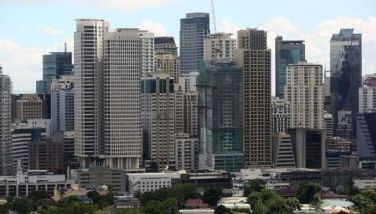Government infrastructure spending rises to P104 billion in May

MANILA, Philippines — The Marcos administration jacked up its infrastructure spending in May by nearly 30 percent to P104 billion following a low base in the same period last year due to the election ban, the Department of Budget and Management (DBM) said.
Based on the latest national government disbursement performance report of the DBM, state infrastructure expenditure and other capital outlays jumped by 29 percent to P103.8 billion in May from P80.5 billion in the same period last year.
The DBM attributed this mainly to the larger disbursements of the Department of Public Works and Highways (DPWH) due to the fast-tracking of implementation and completion of ongoing projects.
This is amid relatively favorable weather conditions, payments of prior years’ accounts payables, and billings for advance payments or mobilization costs.
The growth of infrastructure outlays was also driven by base effects coming from the relatively low base in May 2022 during the election spending ban.
Nonetheless, the DBM said robust disbursements were still recorded such as the local counterpart funds for various foreign-assisted projects of the Department of Transportation (DOTr).
These include the North-South Commuter Railway Project and the Metro Manila Subway Project Phase I, as well as accounts payables for various airport projects and the Cebu Bus Rapid Transit Project.
Resources were also allocated for the delivery of firefighting equipment of the Bureau of Fire Protection, as well as for the construction of buildings and procurement of equipment and motor vehicles for the Philippine National Police.
For the five-month period, infrastructure spending picked up 18.4 percent to P387.8 billion from P327.5 billion.
The DBM said this included payments of the DPWH for their completed infrastructure projects and mobilization costs for their ongoing projects this year, as well as the constructive receipts of cash payments of the DOTr for their foreign-assisted rail projects.
Meanwhile, overall government spending for May was almost flat at P455.7 billion, just almost a percent higher from the P451.7 billion a year ago.
Apart from infrastructure, personnel services expenditures increased by six percent to P162.8 billion due to midyear bonus implementation, as well as allowance payment to healthcare workers and pension requirements of uniformed personnel.
Interest payments also increased by 22.2 percent to P41.3 billion due to larger foreign interest payments, particularly from coupon payments for new loan availment and higher foreign exchange rates this year.
On the other hand, combined allotment and capital transfers to local government units fell 15.8 percent to P74.9 billion on lower tax allotments due to the Mandanas Ruling.
It should be noted that the tax revenue base, from which the tax allotment shares of LGUs this year is determined, was the actual tax collections in 2020 – the height of the pandemic.
The government also recorded lower maintenance and other operating expenses to P63.5 billion due to the timing of release for the Pantawid Pamilyang Pilipino Program.
Lower disbursement was also noted in the Commission on Elections sans the national polls as compared to May 2022.
A decrease in government spending was similarly noted in subsidy support to government corporations which went down to P7.4 billion.
Tax expenditures also went down to P1.8 billion due to the timing of the grant of subsidy to the Philippine Deposit Insurance Corp. for value-added tax payments.
As of end-May, the remaining program balance amounts to P585.7 billion or 11 percent of the record P5.268 trillion 2023 budget.
According to the DBM, disbursements for the second quarter will likely be flat as the lower NTA shares of LGUs will continue to weigh down on spending growth.
This will be coupled with some delays encountered by line agencies in the implementation of subsidy programs and timing of releases to government corporations.
Nonetheless, spending performance of agencies is expected to accelerate toward the end of the third quarter.
“Big- spending departments were advised to undertake measures to ensure the attainment of their respective spending targets for the year, the timely completion of their programs and the prompt delivery of public goods and services,” the DBM said.
The government has set a spending target equivalent to 21.3 percent of gross domestic product this year, while overall infrastructure disbursements will be equivalent to 5.3 percent of GDP.
- Latest
- Trending































